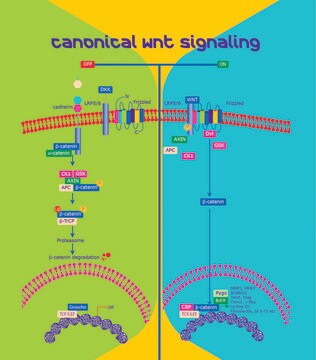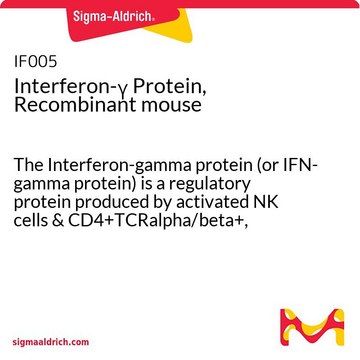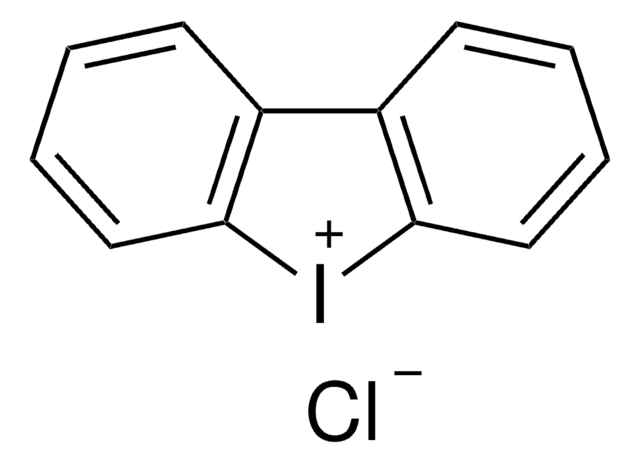GF146
Wnt-5a Protein, Recombinant mouse
The Wnt5a protein is a 352 amino acid protein containing 23 conserved cysteines & contains a cysteine modified by palmitate which is essential for receptor binding & biological activity.
Sign Into View Organizational & Contract Pricing
All Photos(1)
About This Item
UNSPSC Code:
12352202
eCl@ss:
32160405
NACRES:
NA.77
Recommended Products
General description
Product Source: Wnt5a has been purified from conditioned media using blue-Sepharose, gel filtration and heparin affinity chromatography.
Wnt5a, a member of the highly conserved Wnt protein family, is a 352 amino acid protein containing 23 conserved cysteines and contains a cysteine modified by palmitate which is essential for receptor binding and biological activity. The Wnt5a amino acid sequence also contains an N-terminal signal peptide which means the protein is secreted into the medium when expressed in cell culture.
Wnt ligands bind to cell surface co-receptors consisting of a Frizzled protein and lipoprotein receptor related protein (5/6). Wnt 5a belongs to the non-canonical class of Wnt proteins which are independent of or inhibit β-catenin signalling. Wnt5a when bound to its receptor triggers an intracellular Ca release which activates PKC and CaMK11 which in turn activates TAK1 MAPkinase-kinase and nemo-like(NLK) kinase. NLK phosphorylates Lef1/TCF protein complex inhibiting the formation of the β-catenin Lef1/TCF DNA complex. In contrast Wnt3a signalling stabilizes β-catenin increasing the formation of the β-catenin Lef1/TCF DNA complex.
Wnt signalling has been implicated in the control of differentiation of stem cells. The Wnts have also been shown to have putative roles in the regulation of adult stem cells. Recently injection of embryonic stem cells into hearts has been shown to correct cardiac defects. This occurs through the secretion of factors from stem cells which correct gene defects in neighbouring cells. Wnt5a, a short term factor secreted by the stem cells, has been shown to be critical for this process (Fraidenraich and Benzra, 2006).
Wnt ligands bind to cell surface co-receptors consisting of a Frizzled protein and lipoprotein receptor related protein (5/6). Wnt 5a belongs to the non-canonical class of Wnt proteins which are independent of or inhibit β-catenin signalling. Wnt5a when bound to its receptor triggers an intracellular Ca release which activates PKC and CaMK11 which in turn activates TAK1 MAPkinase-kinase and nemo-like(NLK) kinase. NLK phosphorylates Lef1/TCF protein complex inhibiting the formation of the β-catenin Lef1/TCF DNA complex. In contrast Wnt3a signalling stabilizes β-catenin increasing the formation of the β-catenin Lef1/TCF DNA complex.
Wnt signalling has been implicated in the control of differentiation of stem cells. The Wnts have also been shown to have putative roles in the regulation of adult stem cells. Recently injection of embryonic stem cells into hearts has been shown to correct cardiac defects. This occurs through the secretion of factors from stem cells which correct gene defects in neighbouring cells. Wnt5a, a short term factor secreted by the stem cells, has been shown to be critical for this process (Fraidenraich and Benzra, 2006).
Application
• This protein is extremely sticky and will stick to plasticware in the absence of Chaps detergent.
• When using this protein, if possible, dose it directly onto cells at the required dilution without pre-filtering.
• The toxicity of the Chaps in the storage buffer should be tested empirically on the cell line prior to using the Wnt5a protein.
• Generally, we suggest that a minimum dilution of Wnt5a of 1:1000 on mammalian cells results in a final concentration of Chaps that is not toxic to the cells.
• If dosing on cells over a period of days/weeks, it is recommended that media containing Wnt5a is replenished daily, rather than dosing Wnt5a to existing media daily. This is because accumulation of Chaps is undesirable for cell viability.
• When using this protein, if possible, dose it directly onto cells at the required dilution without pre-filtering.
• The toxicity of the Chaps in the storage buffer should be tested empirically on the cell line prior to using the Wnt5a protein.
• Generally, we suggest that a minimum dilution of Wnt5a of 1:1000 on mammalian cells results in a final concentration of Chaps that is not toxic to the cells.
• If dosing on cells over a period of days/weeks, it is recommended that media containing Wnt5a is replenished daily, rather than dosing Wnt5a to existing media daily. This is because accumulation of Chaps is undesirable for cell viability.
Optimal concentrations should be determined for each application.
Packaging
8-10 μg/vial
Physical form
Frozen liquid in PBS containing 1.0% Chaps.
Storage and Stability
Maintain the frozen material at -20 °C until expiration date as stated on the label. Upon receipt, thaw and aliquot into single-use aliquots and store at -20 °C. Once a single-use aliquot has been thawed, DO NOT re-freeze. Store thawed material at 4 °C for up to one month.
Analysis Note
Specific Activity: The biological activity of Wnt5a has been demonstrated by its ability to antagonize the induction of alkaline phosphatase synthesis by Wnt3a in the presence of BMP4 by C2C12 osteoblastic cells.The EC50 for this effect is typically 100 ng/mL
Legal Information
CHEMICON is a registered trademark of Merck KGaA, Darmstadt, Germany
Disclaimer
Unless otherwise stated in our catalog or other company documentation accompanying the product(s), our products are intended for research use only and are not to be used for any other purpose, which includes but is not limited to, unauthorized commercial uses, in vitro diagnostic uses, ex vivo or in vivo therapeutic uses or any type of consumption or application to humans or animals.
Storage Class
13 - Non Combustible Solids
wgk_germany
WGK 2
flash_point_f
Not applicable
flash_point_c
Not applicable
Certificates of Analysis (COA)
Search for Certificates of Analysis (COA) by entering the products Lot/Batch Number. Lot and Batch Numbers can be found on a product’s label following the words ‘Lot’ or ‘Batch’.
Already Own This Product?
Find documentation for the products that you have recently purchased in the Document Library.
Embryonic stem cells prevent developmental cardiac defects in mice
Fraidenraich, Diego and Benezra, Robert
Nature Clinical Practice. Cardiovascular Medicine, 3 Suppl 1, S14-S17 (2006)
Related Content
This article shows that a PES membrane containing Stericup Quick Release filter provides an alternative for the pluripotent expansion of embryonic stem cells.
Our team of scientists has experience in all areas of research including Life Science, Material Science, Chemical Synthesis, Chromatography, Analytical and many others.
Contact Technical Service







